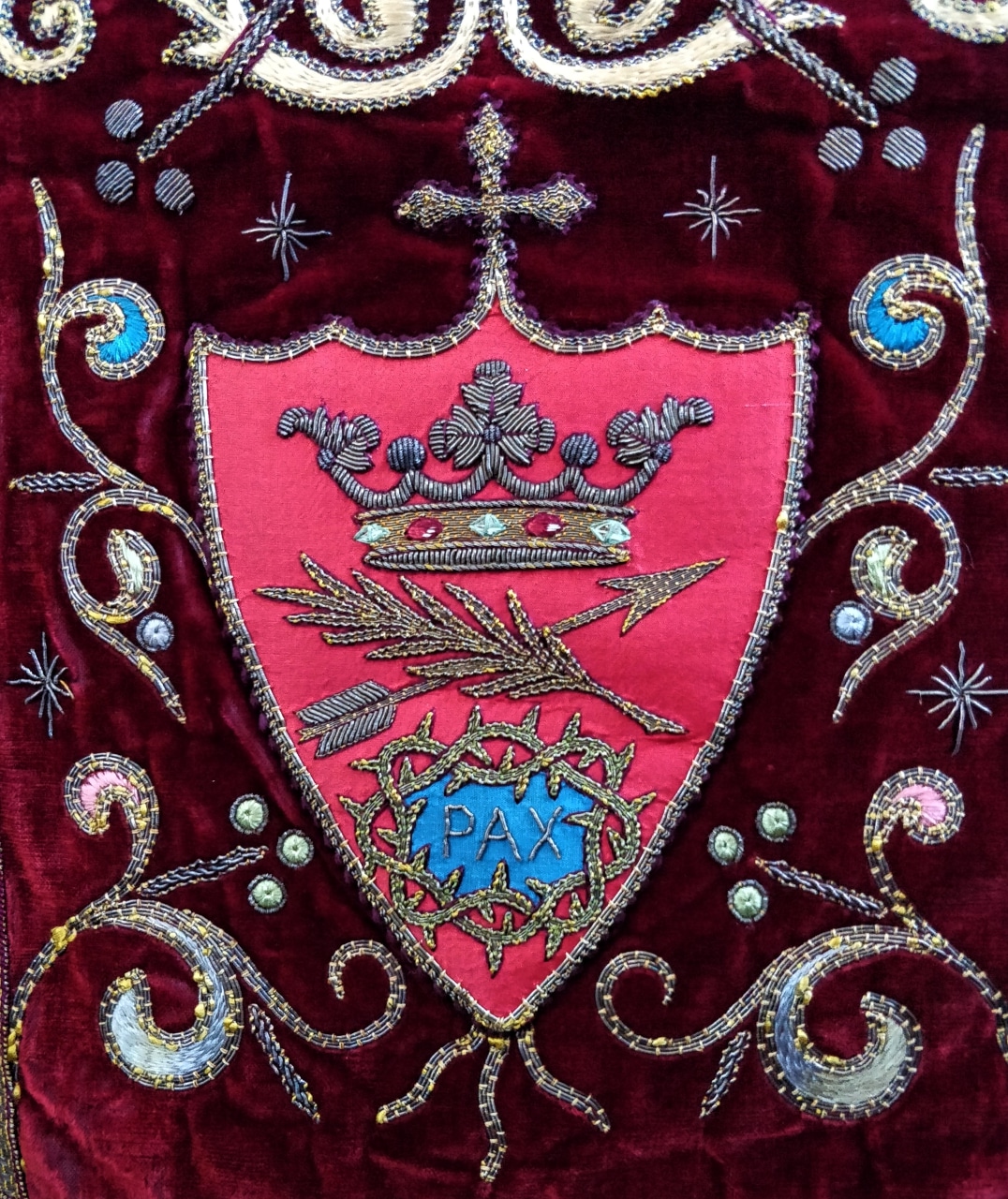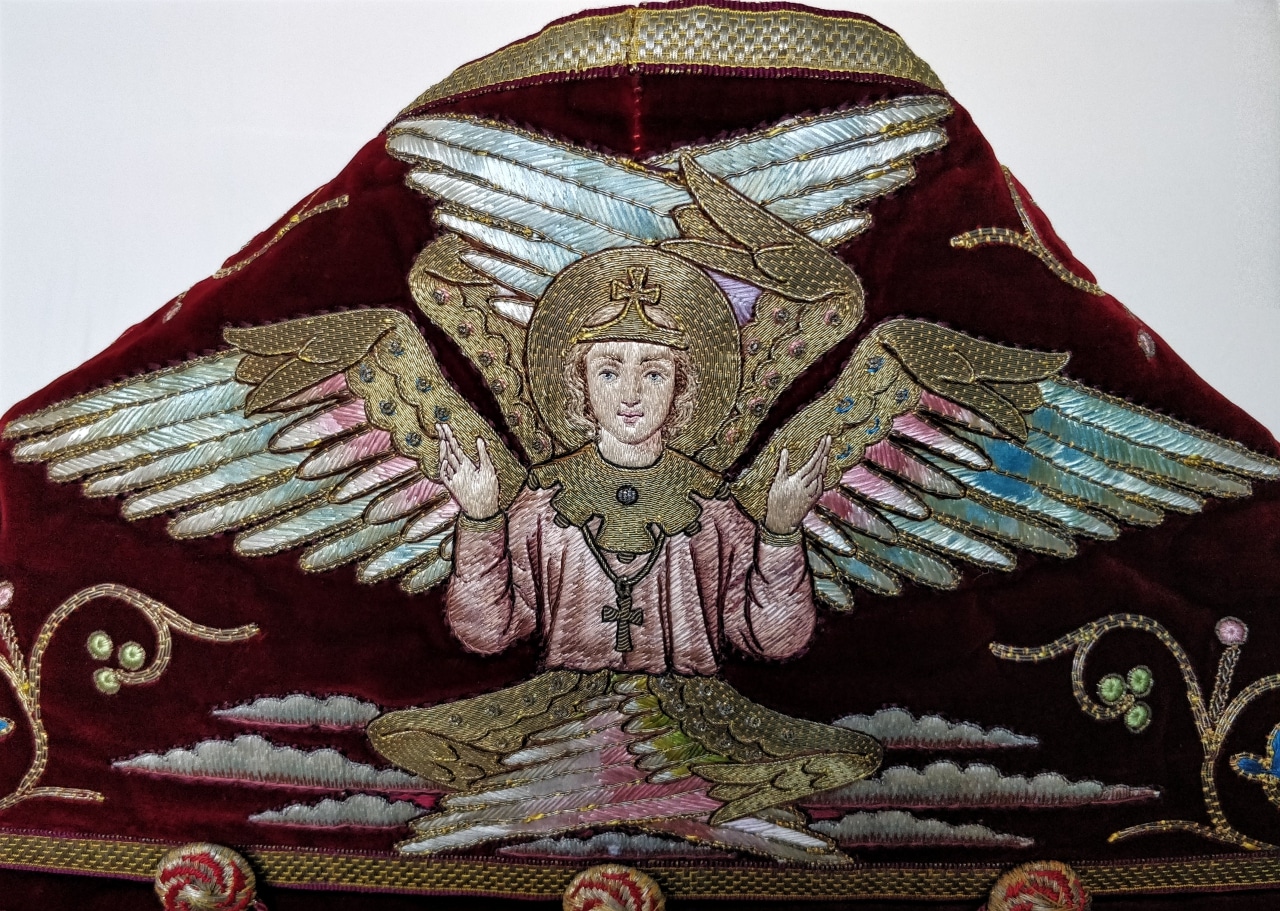It’s been a busy day so just one piece today in the series on Douai Abbey’s Ward vestments. Today it is the cope.
The cope was another significant piece of the set that was ready in 1896, though in that year the morse for it had not yet been made. It is essentially easy to describe: the orphreys on the front show the 12 apostles grouped in pairs.

At the bottom of the orphreys is a large reproduction of the old Douai armorial shield on the one, and that of the benefactor, Edmund Granville Ward, on the other.


The back of the cope is no less remarkable.

At the neck is a rather splendid embroidery of a six-winged seraph.

Beneath it, on the hood, is a Pentecost panel, with the Spirit descending on Mary and the apostles.

The morse depicts St George, rather a generous gesture from the community of St Edmund to the saint who supplanted its patron as the English patron.

Also made for the set were two morses for cantors copes which are not part of the original set, but are also made of crimson velvet and are striking in themselves. The cantors’ morses depict St Benedict and his sister St Scholastica.


God willing, the dalmatic tomorrow.
Pax.

again, beautiful craftsmanship that tells a beautiful story
Indeed it does!
The panel of St. George seems to me to be in a different, less realistic style than the others, and almost to look like an imitation of medieval enamel. Does anyone agree?
Such stunning work! The cope hood is beautifully embroidered. One can only imagine the hours of work that went into crafting such a piece.
Thank you for sharing.
Seeing the panels on another electronic devise, it now sseems to me that they not only look like enamel but are enamel. Could Dr. Hugh please confirm or disconfirm? If they are enamel, I would like to know if atrching enamela to vestments was standard or common either in the Middle Ages or the Gothic Revival.
I think they are enamel, dating from the same period as the vestments themselves. As to the historic use of morses I have no knowledge, alas.
Hello Allen! They do seem to be enamel and are rather nicely worked. See below for Sue’s excerpt for the Catholic Encyclopaedia regarding the morse.
Pax!
I hadn’t come across the term ‘morse’ before (other than the surname of Samuel, of code fame, and Endeavour), but here’s the Catholic Encyclopaedia entry:
“Also called the MONILLE, FIRMULA, FIRMULE, PECTOIRALE, originally the rectangular ornamented piece of material attached to the two front edges of the cope near the breast to prevent the vestment from slipping from the shoulders. Morses were provided with hook and eye, and were often richly ornamented with embroidery or precious stones. The name was also applied to metal clasps used instead of such pieces of woven fabric. As early as the eleventh century such metal clasps are found represented in miniatures and mentioned in inventories. These clasps, however, gradually lost their practical use and became were ornaments, which were sometimes sewn firmly to the flaps that served to fasten the cope, sometimes only attached to the flaps by hooks, so that, after the vestment had been worn, the clasps could be removed and cared for separately. This latter was especially the case when, as frequently happened at least in the later Middle Ages, the clasp was very heavy or very valuable. As early as the thirteen century inventories clasps which formed distinct ornaments in themselves. Many churches had a large number of such morses. They were generally made of silver covered with gold, and were ornamented with pearls, precious stones, enamel, niello-work, architectural designs, small, figures of saints, ornamental work in flowers and vines and similar designs. Such clasps were frequently the finest products of the goldsmith’s art; they were generally either round, square, quatrefoil, or like a rosette in form; yet there were also more elaborate and at times peculiar shapes. Abundant proof of the desire for costly clasps for the cope is shown by the old inventories and by the numerous medieval morses preserved (especially in Germany) in churches and museums. According to present Roman usage the morse is reserved to cardinals and bishops (“Caer. episc.”, I, c. vii, n. 1; S. R. C:., 15 September, 1753).”
In this case, one assumes that the cope isn’t reserved for cardinals and bishops – is the Abbot of Douai equal in rank to a bishop, as I know many mediaeval abbots (and abbesses) were?
Welcome! The restriction of the morse to prelates alone is, I suspect, no longer in force. The two morses depicting Sts Benedict and Scholastica are for the cantors’ copes, and they were made at the end of the nineteenth century. Nevertheless, you are right in your guess about the abbots of Douai: they are mitred abbots, like the other English Benedictine abbots, and rank as ordinaries (and major superiors of religious).
Pax!
The vestments are so stunning, there must surely somewhere be a record of their maker – but perhaps it was a Benedictine convent? (Stanbrook, possibly?) The six-winged ‘apocalyptic’ seraph looks as if it might be modelled on a Byzantine or even Asian original, and the Pentecost scene too looks as if adapted from a Greek depiction.
I wonder where the quotation on the figures of SS Benedict and Scholastica is from? ‘Give the thankyss that are due’ – it looks as if derived from a Middle English text, could it be an English mystic such as Julian or Margery Kempe?
Mancunius: that’s an interesting question, and I did a bit of Googling. It turns out that “Give the thankyss that are due” was the motto of the Ward family (cf https://books.google.com/books?id=1uBOAAAAYAAJ&pg=PA305&lpg=PA305&dq=Give+the+thankyss+that+are+due&source=bl&ots=ZJ1Xj3E8Hv&sig=mXG6s6EAnTow-w5OSmmvIUCuL5k&hl=en&sa=X&ved=0ahUKEwjlr42Du7bbAhWDxFkKHcWnD0sQ6AEIOjAB#v=onepage&q=Give%20the%20thankyss%20that%20are%20due&f=false), which explains the text on the cope: the donor obviously gave instructions to the embroiderers (I too wonder who they were) to include his family motto.
It’s in the preceding post – Grossé of Bruges made them.
And indeed, that is the motto of the Ward family. EGW’s arms are all over the vestments!